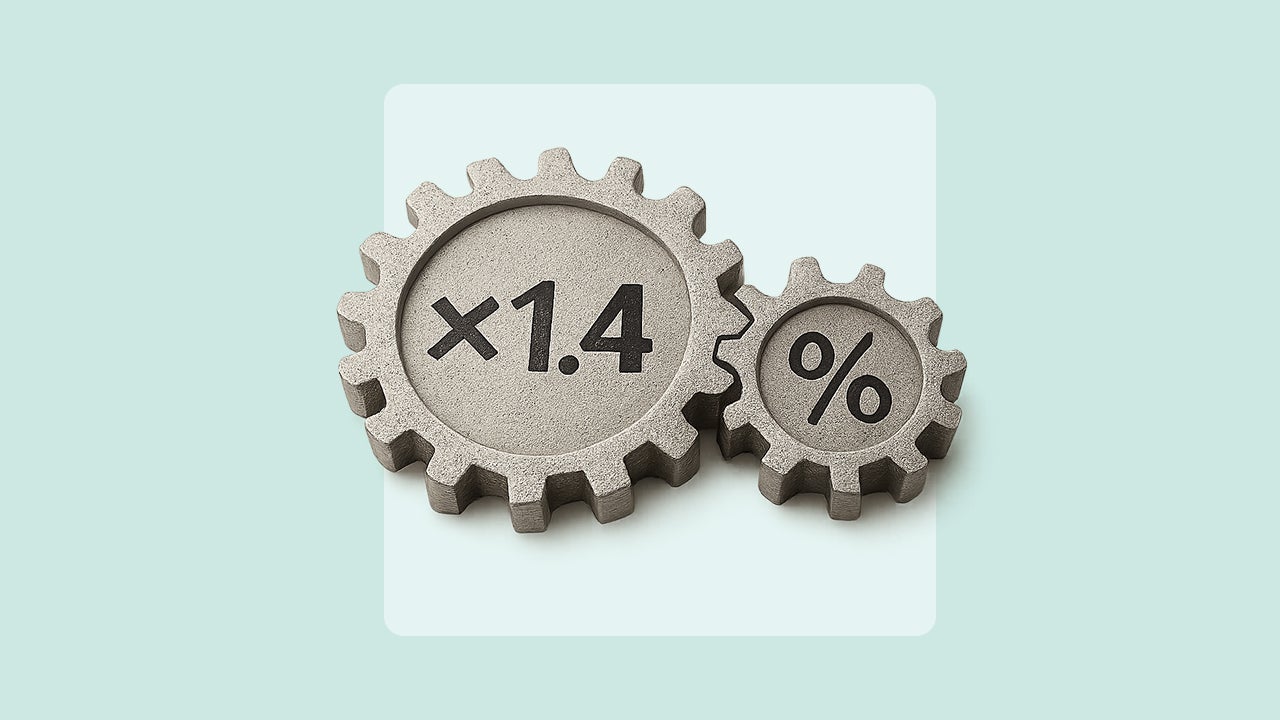Photography by Getty Images; Illustration by Bankrate
Key takeaways
- Factor rates are a decimal that you use to multiply the entire loan by to get the total loan cost.
- Factor rates do not incorporate loan fees into its rate, as APRs do, making it difficult to evaluate the total cost of the loan.
- Factor rate loans tend to cost more than loans with an interest rate.
A factor rate is a multiplier that some lenders use to calculate the total cost of a business loan. This rate is used instead of an annual percentage rate (APR).
Factor rates are most common with bad credit and alternative types of business loans, such as merchant cash advances. These loans are typically short term, and they may come with additional fees that aren’t common to other business loans.
Unlike an APR, a factor rate doesn’t incorporate loan fees when determining the loan cost. Factor rates make it difficult to determine the true cost of a factor rate loan. You can more easily compare loan costs when you convert the factor rate to an annual interest rate.
How do factor rates work?
Factor rates are expressed as a decimal, usually between 1.10 or 1.50, which then gets multiplied by the amount you’re borrowing. The final amount is the cost of the loan, not including additional fees the lender may charge.
How to calculate a factor rate
Determine your loan’s total cost with this formula:
Principal loan amount x factor rate = total loan cost
Let’s say you get a loan for $75,000 with a 1.30 factor rate spread across 18 months. If you plug in the numbers, you would multiply $75,000 x 1.30 to get $97,500 as your total loan cost.
If you just want to know the cost you’ll be charged, you would subtract the amount borrowed from the total loan cost: $97,500 – $75,000 = $22,500.
Factor rates vs. interest rates
| Factor rates | Interest rates | |
| Cost of borrowing | Expressed as a decimal | Expressed as a percentage of loan principal |
| Includes lender fees | No | APR includes fees |
| Fixed or variable costs | Fixed upfront cost | Fixed or variable rates over life of loan |
| Save money with early payoff | No, unless a discount is offered | Yes |
| Typical use | Short-term financing | Longer-term loans and lines of credit |
A factor rate is a percentage of the loan amount needed for loan repayment, expressed as a decimal. An interest rate the cost a lender charges for borrowing money, expressed as a percentage of the loan’s principal.
How to convert factor rates to interest rates
To compare loans with factor rates and interest rates and ensure you’re getting the most affordable loan, find the annual interest charged for the factor rate loan.
Here’s how to convert factor rates to interest rates, using the example of a $75,000 loan with a factor rate of 1.30 repaid over 18 months.
Method one: Long formula
Long formula
1. Calculate the total loan cost by multiplying the amount borrowed by the factor rate.
2. Subtract the total loan cost from the amount borrowed to see the interest charged.
3. Convert the interest charged to a percentage. To do that, divide the total interest charged by the amount borrowed.
4. Convert the total interest rate to an annual rate in two steps.
a) Multiply the decimal by the number of days in a year.
b) Then, divide by the number of days in the repayment term.
5. Change to a percentage by multiplying the decimal by 100.
Here’s an example of how that works:
- Step one: $75,000 (amount borrowed) x 1.30 (factor rate) = $97,500 (total loan cost)
- Step two: $97,500 (total loan cost) – $75,000 (amount borrowed) = $22,500 (total interest charged)
- Step three: $22,500 (total interest charged) / $75,000 (amount borrowed) = 0.30 (interest as a decimal)
- Step four:
- a) 0.30 (interest as decimal) x 365 (days in a year) = 109.50
- b) 109.50 / 547.5 (days in 18-month term) = 0.20 (annual interest)
- Step five: 0.20 (annual interest) x 100 = 20% (annual interest rate)
Method two: Simplified formula
This method of converting a factor rate to an interest rate simplifies the steps used in method one. To do this:
Simplified formula
1. Subtract 1 from the factor rate.
2. Multiply by 365 days in a year.
3. Divide the decimal by the number of days in your repayment term.
4. Multiply the decimal by 100 to get the annual interest rate.
Here’s an example of this calculation process:
- 1.30 (factor rate) – 1.00 = 0.30
- 0.30 x 365 (days in a year) = 109.50
- 109.50 / 547.5 (days in repayment term) = 0.20 (interest as a decimal)
- 0.20 (interest as a decimal) x 100 = 20% (annual interest rate)
Compare factor rates to interest rates
Now that we know a $75,000 loan with a factor rate of 1.30 converts to a 20 percent interest rate when paid off in 18 months, we can compare costs.
The $75,000 loan with a factor rate of 1.3 costs $22,500. Using a business loan calculator, here’s how much interest you’d pay and the total cost of a loan with an APR of 20 percent.
| Loan amount | $75,000 | $75,000 | $75,000 |
|---|---|---|---|
| Interest rate | 20% | 20% | 20% |
| Repayment period | 12 | 18 | 24 |
| Interest paid | $8,371.06 | $12,430.32 | $16,612.44 |
| Total cost | $83,371.06 | $87,430.32 | $91,612.44 |
As you can see, a loan with a comparable APR costs less than a loan with a factor rate. This is why you should shop around to see if you qualify for loans with a comparable APR before accepting a loan with a factor rate.
Comparing factor rates vs. interest rates over time
Paying the above factor rate loan off in 18 months gives you a comparable interest rate of 20 percent.
However, a 12-month repayment period is comparable to a 30 percent annual interest rate. A six-month repayment period is comparable to a 60 percent annual interest rate.
When and why lenders use factor rates
Lenders often use factor rates when they need a simplified lending option and typically one that needs quick funding times. The flat rate makes it simpler for the lender’s underwriting and repayment structure. This is commonly used by alternative lenders, such as those offering short-term business financing options or merchant cash advances where the repayment is tied to future credit card sales.
When to take a loan with factor rates
The main reasons that you might take out a loan with factor rates are:
- It’s accessible to high-risk borrowers. Bad credit loans and alternative types of financing like merchant cash advances tend to use factor rates. These are aimed at helping borrowers who don’t qualify for traditional loans or who need fast funding.
- You find costs are similar to loans with an APR. You might get a loan with a factor rate if you convert the factor rate to interest and find that the cost is similar to loans with an APR. But make sure to compare the factor rate loan with other loans to see if you can get a better rate or repayment terms.
When factor rates may not be in your best interest
- You need a short repayment timeline. Factor rates do not account for the length of time with repayment, so paying back the funds in the short-term will result in a higher borrowing cost.
- Your cash flow is inconsistent. Funding options like merchant cash advances typically deduct payments from daily or weekly credit card sales. If your cash flow remains unpredictable, then it may be too difficult to keep up with repayment.
Bottom line
Generally, business loans with a factor rate cost more in interest and fees than loans with an APR. Yet the only way to get an idea of the borrowing cost is to convert the factor rate to an annual interest rate.
The converted interest rate won’t compare directly to an APR, but it gives you a close comparison of interest charged minus loan fees. Then, you can decide whether you should sign for a factor rate loan or look for another option with lower rates.
Frequently asked questions
Why we ask for feedback
Your feedback helps us improve our content and services. It takes less than a minute to
complete.
Your responses are anonymous and will only be used for improving our website.
Help us improve our content
Read the full article here





